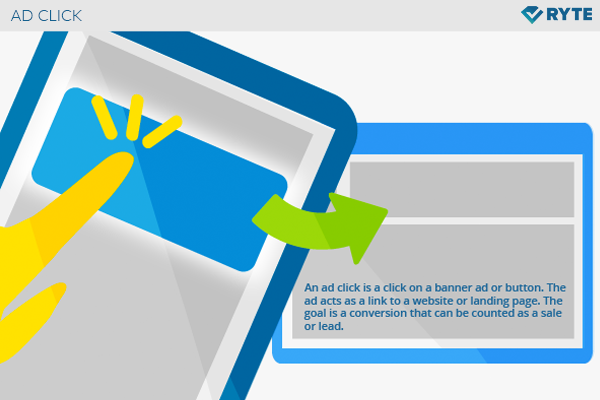Ad Click
An ad click is a click on a banner ad or button. The ad acts as a link to a website or landing page. The goal is a conversion that can be counted as a sale or lead. The number indicates whether an advertising campaign on the internet is successful, or may be so in the future.[1] The ad click rate is the relationship between visual contacts with the advertising material (ad impressions) and the number of user clicks. Many campaigns in affiliate marketing, display ad marketing, and paid search are based on the calculation of ad clicks. The calculation model is called pay per click (short: PPC) or cost per click (CPC).
General information
If a user visits a website that contains graphic advertising material, this is counted as an impression. If the user interacts with the advertising material by clicking it, they will be directed to a broader offer through a hyperlink that links the advertising material to a secondary more detailed listing. This may be the website they are advertising for, but the category, product or login pages for newsletters can also be referenced.[2] The purpose of the banner is of course to encourage users to click. However, the subsequent interaction is the main focus the campaign. The manner of interaction is therefore dependent on the objectives of the campaign. It can be aimed at increasing the reach of advertisement, traffic or sales.
Functionality
A click on an ad is usually registered by an ad server. The ad server sorts placed ads, publisher websites and clicks that have been generated by an ad on these websites. Other tracking methods such as cookies or canvas fingerprints are often used to assign an ad click to an actual visitor of a website because crawlers, bots and automated scripts can also trigger an ad click.[3] This may affect the effectiveness of advertising campaigns and is called click fraud if done with fraudulent intent.[4] Possible countermeasures constitute a correct counting of clicks, so that server-side scripts, crawlers and bots are excluded and only natural users are included in the calculation.
Example of ad click rate
If a banner is integrated on a website and linked to a landing page, the number of ad impressions will be counted as a visit. For example, if a website has 1000 visitors a month. and any user or visitor who clicked on the banner is counted as an ad click, if 50 users clicked on the banner, the ad click rate amounts to 5%.
Increasing ad clicks
There are different strategies for increasing the number of ad clicks. Campaigns can be tailored to the market, industry and target audience even before media planning.[5] Through segmentation, relevant keywords and interesting environments for cooperation (such as paid search, display campaigns or topically appropriate websites and blogs) can be determined. The advertising message itself should be adapted to the target group and the environment in which it is advertised.
Advertisers should also know what stage of the marketing funnel the user is at when they click an ad. Users don’t need to be ready for a purchase in every single campaign, which is why in this case, transactional keywords don't necessarily need to be used. Sometimes the goal is a lead in the form of a record. Therefore, it is necessary to cover informal and conversational keywords for some campaign goals. Content marketing can support the campaign. Helpful landing pages with relevant, useful content can then be the jump destinations of advertising banners.
Moreover, graphical changes of banners, textual layout, as well as adaptations of headlines and copy text are can improve the effectiveness of ads. Incentives, activating words, recommendations from customers, or the deliberate omission of the price may also increase the ad click rate.[6] A/B tests are useful in this context to determine which ads generate high click-through rates.[7]
Importance for online marketing
Ad clicks and ad click rate form the basis for evaluating the effectiveness of ads. This calculation model is indeed the most widespread, but it also has weaknesses. The advertiser pays for each click on an ad. But that does not mean that the user will bring revenue to the business that is advertising. If a campaign is focused on sales, the calculation can therefore be carried out based on the number of products sold. The ad click rate in this case is more a representation of the rate of responses, which gives information about the acceptance of the advertising material used, rather than a reliable value with which to determine the ROI.
References
- ↑ AdClick Prediction eecs.tufts.edu. Accessed on 03/13/2015
- ↑ How Affiliate Marketing Works webopedia.com. Accessed on 03/13/2015
- ↑ 10 Horrifying Stats About Display Advertising blog.hubspot.com. Accessed on 03/13/2015
- ↑ What Is Pay Per Click Fraud and How Does It Work? spamlaws.com. Accessed on 03/13/2015
- ↑ 50 Strategies To Increase Click Through Rate Via PPC Advertising searchenginejournal.com. Accessed on 03/13/2015
- ↑ 10 Quick Ways to Increase Your Ads' Clickthrough Rates entrepreneur.com. Accessed on 03/13/2015
- ↑ 8 Quick Ways to Increase Your AdWords CTR searchengineland.com. Accessed on 03/13/2015

